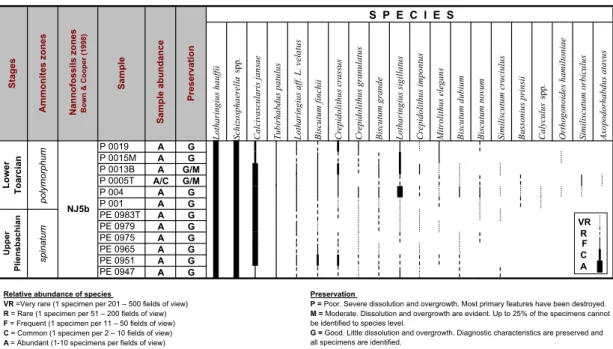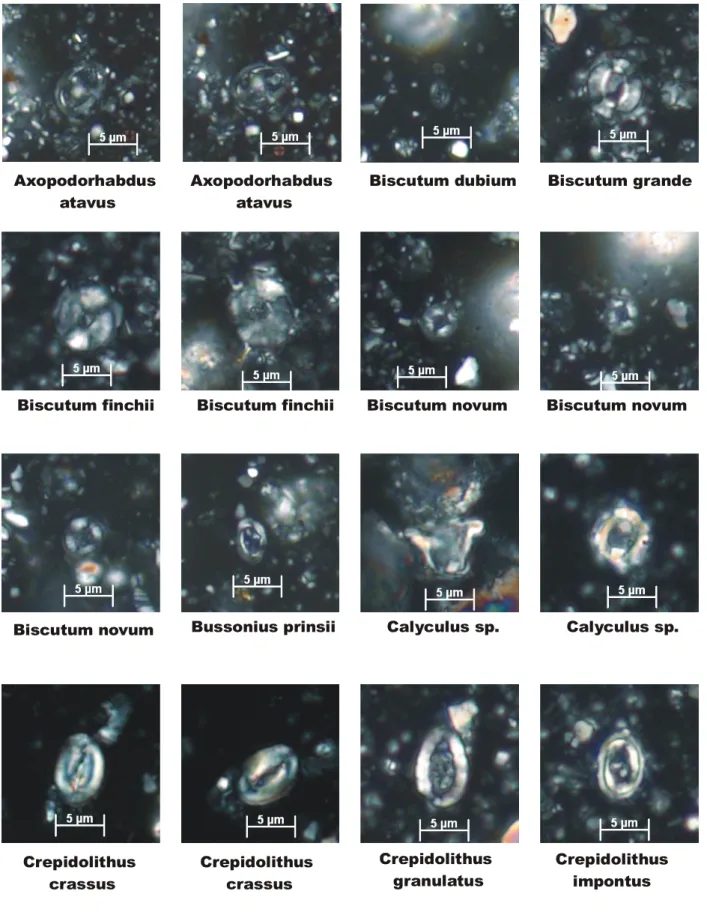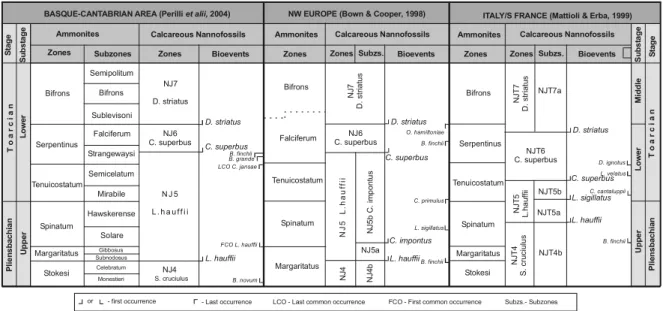Calcareous nannofossil assemblages around the
Pliensbachian/Toarcian boundary in the reference section
of Peniche (Portugal)
L. C. Veiga de Oliveira
1, N. Perilli
2& L. V. Duarte
31 Petrobras/Cenpes, Cidade Universitária, Ilha do Fundão, 21941-915, Rio de Janeiro, Brazil; lcveiga@petrobras.com.br 2 Dipartimento Scienze della Terra, Università degli Studi di Pisa, Via S. Maria, 53, 56100 Pisa, Italy; perilli@dst.unipi.it 3 Departamento de Ciências da Terra, Faculdade de Ciências e Tecnologia, Universidade de Coimbra, 3000-272 Coimbra, Portugal;
lduarte@dct.uc.pt
Resumo
Palavras-chave: Nanofósseis calcários, Pliensbaquiano, Toarciano, Bacia Lusitânica, Portugal
O limite Pliensbaquiano/Toarciano (Jurássico Inferior) está bem representado na Bacia Lusitânica (Portugal), principalmente em Peniche, através de uma sucessão margo-calcária alternante. Visando contribuir para a definição do GSSP do Toarciano, são descritas aqui as associações de nanofósseis ocorrentes nesses depósitos. As análises foram realizadas em amostras de margas
recolhidas 3 m abaixo e 7 m acima deste limite. Os principais nanofósseis observados foram Biscutum finchii, B. grande,
Calcivascularis jansae, Crepidolithus crassus,C. granulatus,C. impontus,Lotharingius hauffii,L. sigillatus,L. aff. L. velatus,
Schizosphaerellaspp. e Tubirhabdus patulus. Esta associação, aliada ao aparente posicionamento das amostras acima da extinção deCrucirhabdus primulus, indica que o limite Pliensbaquiano-Toarciano estaria localizado na parte superior da subzona NJ5b. Os
exemplares dos géneros Schizosphaerella e Lotharingius dominam no conjunto da associação, também caracterizada pela
ocorrência abundante de C. jansae e comum de B. grande, indicadores de forte influência de águas do Mar de Tétis.
Résumé
Mots-clés: Nanofossiles calcaires, Pliensbachien, Toarcien, Bassin Lusitanien, Portugal
La limite Pliensbachien/Toarcien (Jurassique Inférieur) est très bien représentée dans le Bassin Lusitanien (Portugal), principalement à Peniche, par une succession marno-calcaire alternante. Visant à apporter une contribution à la définition du GSSP du Toarcien, sont ici décrites les associations de nanofossiles dans ces dépôts. Des analyses ont été réalisées sur des échantillons de marnes recueillies 3 m en dessous et 7 m au dessus de cette limite. Les principaux nanofossiles signalés ont été:
Biscutum finchii,B. grande,Calcivascularis jansae, Crepidolithus crassus,C. granulatus,C. impontus,Lotharingius hauffii,L.
sigillatus,L. aff. L. velatus,Schizosphaerella spp. et Tubirhabdus patulus. Cette association, liée à la localisation apparent des échantillons au dessus de l’extinction de Crucirhabdus primulus, indique que la limite Pliensbachien-Toarcien serait localisée
dans la partie supérieure de la sous-zone NJ5b. Les individus des genres Schizosphaerella et Lotharingius prédominent dans
l’association, qui est aussi caractérisée par l’abondante fréquence de C. jansae et la présence de B. grande, indicateurs de forte influence des eaux de la Tethys.
Abstract
Key-words: Calcareous nannofossils, Pliensbachian, Toarcian, Lusitanian Basin, Portugal
The Pliensbachian/Toarcian boundary (Lower Jurassic) is well represented in the Lusitanian Basin (Portugal), mainly in the Peniche area, recorded by a marl/limestone series. Calcareous nannofossil assemblages are described herein, with the aim to contribute to the Toarcian GSSP definition. Marly samples were collected 3 m below and 7 m above this boundary and analysed
for calcareous nannofossils. The main nannofossils observed were Biscutum finchii, B. grande, Calcivascularis jansae,
Crepidolithus crassus,C. granulatus,C. impontus,Lotharingius hauffii,L. sigillatus,L. aff. L. velatus,Schizosphaerella spp. and
Tubirhabdus patulus. This assemblage indicates that the Pliensbachian/Toarcian boundary in Peniche lies in the upper part of the
NJ5b Subzone. Schizosphaerella and Lotharingius dominate the assemblage. The abundant occurrence of C. jansae and the
common occurrence of B. grande indicate a strong Tethyan influence.
Introduction
The high biostratigraphic potential of the Lower Jurassic calcareous nannofossils is well documented in the papers of P. BOWN (1987), P. BOWN & al. (1988), P. BOWN& M. COOPER (1998), E. de KAENEL & al. (1996) and E. MATTIOLI & E. ERBA (1999), among others. They are based on calcareous nannofossil record recovered from many sections located in NW Europe and Mediterranean areas. The biohorizon succession and the calcareous nannofossil zones and subzones proposed for NW Europe (from Hettangian to Tithonian) and Italy/South France (from Hettangian to Callovian) are discussed by P. BOWN & M. COOPER
(1998) and E. MATTIOLI& E. ERBA (1999), respectively. As a part of a multidisciplinary work, are also available data on Pliensbachian to Aalenian calcareous nannofossil assemblages recovered from different sections selected along the western (Lusitanian Basin) and northeastern (Basque-Cantabrian area and Iberian Range) margins of the Iberian Massif. In particular, the Pliensbachian-Toarcian calcareous nannofossil data set achieved for the Basque-Cantabrian area (PERILLI, 1999; PERILLI & COMAS -RENGIFO, 2002) is discussed in the paper of N. PERILLI
& al. (2004). Previously studied by G. HAMILTON (1977, 1979), P. BOWN (1987) and BERGEN (in de KAENEL & al., 1996), the calcareous nannofossil contents of the Toarcian succession cropping out in the Lusitanian Basin has been investigated by N. PERILLI& L. DUARTE (2003), L. DUARTE
& al. (2004) and N. PERILLI& L. DUARTE (2006). The ongoing works are focused on the Sinemurian-Pliensbachian and Aaalenian calcareous nannofossils recovered from other key-sections located in the Lusitanian Basin.
Samples and methods
For the aim of this meeting, the preliminary data on calcareous nannofossil analyses recovered from the
calcareous-marly succession exposed at Ponta do Trovão (Cabo Carvoeiro, Peniche) is here summarized. 12 analyzed marly samples were collected from 3 meters below to 7 meters above the Pliensbachian/Toarcian Stage Boundary. The slides were prepared in the Petrobras Research
Center (CENPES – BPA) laboratories, applying the Petrobras
standard methodology (ANTUNES, 1997; OLIVEIRA, 1997). The analysis was performed with a ZEISS
Axioplan 2 imaging microscope, using 1600X
magnification. 500 fields of view were examined on each slide. The relative abundance of the assemblages and the relative abundance of each species (Table I) were based on the scheme presented by A. CONCHERYO& S. WISEJR. (2001). The preservation degree was based on the classification of P. ROTH& H. THIERSTEIN (1972).
Calcareous assemblages
All the samples analyzed yielded common to abundant and moderate to good preserved nannofossil assemblages, that allows to recognized 12 genera and 18 species (Table I; figs. 1 and 2). The genera Schizosphaerella along with Lotharingius hauffii and Calcivascularis jansae dominate the assemblages, which are also characterized by the continuous presence of Tubirhabdus patulus, Biscutum finchii, Biscutum grande, Lotharingius aff. L. velatus, Crepidolithus crassus, Crepidolithus granulatus. Ranging in abundance from very rare to few, Biscutum dubium, Biscutum novum, Bussonius prinsii, Calyculus spp., Mitrolithus elegans, Orthogonoides hamiltoniae, Similiscutum cruciulus and Similiscutum orbiculus are, instead, discontinuously present. Few specimens of Axopodorhabdus atavus has been identified only in one sample. Present from the bottom of the sampled interval, the relative abundance of Crepidolithus impontus and Lotharingius sigillatus slightly increase upwards, in particular that of Lotharingius sigillatus.
Table I – Calcareous nannofossil distribution in the studied interval.
S ta g e s A m m o n it e s z o n e s N a n n o fo s s il s z o n e s B o w n & C o o p e r (1 9 9 8 ) S a m p le P re s e rv a ti o n
S P E C I E S
S a m p le a b u n d a n c e L o th a ri n g iu s h a u ff ii S ch iz o sp h a er el la sp p . C a lc iv a sc u la ri s ja n sa e T u b ir h a b d u s p a tu lu s L o th a ri n g iu s a ff . L . ve la tu s Biscu tu m fin ch ii C re p id o lith u s cr a ss u s C re p id o lith u s g ra n u la tu s B is cu tu m g ra n d e L o th a ri n g iu s si g il la tu s C re p id o li th u s imp o n tu s M itr o lith u s ele g a n s B is cu tu m d u b iu m B is cu tu m n o vu m S imiliscu tu m cru ciu lu s B u ss o n iu s p ri n si i C a ly cu lu s sp p . O rt h o g o n o id es h a m il to n ia e S imiliscu tu m o rb icu lu s A xo p o d o rh a b d u s a ta vu s L o w e r T o a rc ia n p o ly m o rp h u m NJ5b
P 0019 A G P 0015M A G P 0013B A G/M P 0005T A/C G/M P 004 A G P 001 A G
Upper P li e n s b a c h ia n s p in a tu m
PE 0983T A G PE 0979 A G PE 0975 A G PE 0965 A G PE 0951 A G PE 0947 A G
Relative abundance of species
VR =Very rare (1 specimen per 201 – 500 fields of view)
R = Rare (1 specimen per 51 – 200 fields of view)
F = Frequent (1 specimen per 11 – 50 fields of view)
C = Common (1 specimen per 2 – 10 fields of view)
A = Abundant (1-10 specimens per fields of view)
Preservation
P = Poor. Severe dissolution and overgrowth. Most primary features have been destroyed.
M =Moderate. Dissolution and overgrowth are evident. Up to 25% of the specimens cannot be identified to species level.
G = Good. Little dissolution and overgrowth. Diagnostic characteristics are preserved and all specimens are identified.
B.
Biscutum dubium Biscutum grandeBiscutum finchii Biscutum novum Biscutum novum
Biscutum novum Bussonius prinsii Calyculus sp.
Crepidolithus crassus
Crepidolithus granulatus
Crepidolithus impontus Axopodorhabdus
atavus
Calyculus sp. Biscutum finchii
Axopodorhabdus atavus
Crepidolithus crassus
Lotharingius sigillatus
Lotharingius aff. L. velatus
Mitrolithus elegans
Calcivascularis jansae
Schizosphaerella sp. Orthogonoides
hamiltoniae
Similiscutum orbiculus
Similiscutum cruciulus
Tubirhabdus patulus
Tubirhabdus patulus Lotharingius
sigillatus Lotharingius
hauffii
Calcivascularis jansae Lotharingius
aff. L. velatus
Schizosphaerella sp.
Lotharingius hauffii
Remarks
In figure 3 is redraw the Upper Pliensbachian-Lower Toarcian portion of the biostratigraphic schema proposed by P. BOWN & M. COOPER (1998) and E. MATTIOLI & E. ERBA (1999) and the zonal markers utilized to define their calcareous nannofossil zone and subzones boundaries. The figure is implemented with the biohorizons and calcareous nannofossil zones recognized in the Basque-Cantabrian area (PERILLI & al. 2004, cum bibliografia) well calibrated with respect to the ammonite subzones. In NW Europe and Italy/S France, the Pliensbachian/Toarcian boundary lies in the Lotharingius hauffii Zone (i.e., Zone NJ5 and NJT5),
that is, within the NJ5b Crepidolithus impontus Subzone of P. BOWN& M. COOPER (1998) or coincides with the
NJT5a Biscutum finchii/NJT5b Lotharingius sigillatus Subzone boundary of E. MATTIOLI & E. ERBA (1999). In the Basque-Cantabrian area, the successive FCO1 Lotharingius hauffii and the LCO1 of Calcivascularis jansae allow to divide the NJ5 Lotharingius hauffii Zone in three portions, and the Pliensbachian/Toarcian boundary is comprised between the FCO Lotharingius hauffii and the LCO of Calcivascularis jansae. Since the FCO of L. hauffii roughly approaches the NJ5a/NJ5b Subzone boundary of P. BOWN & M. COOPER (1998), the Pliensbachian/Toarcian boundary lies within the NJ5b Subzone, in the Basque-Cantabrian area.
Zones Zones Zones Zones Zones Zones
S u b s ta g e S u b s ta g e S ta g e S ta g e U p p e r Semipolitum Serpentinus Bifrons Tenuicostatum Spinatum Spinatum Margaritatus Margaritatus Sublevisoni Falciferum Strangewaysi Semicelatum Mirabile L o w e r T o a r c i a n P li e n s b a c h ia n
Ammonites Calcareous Nannofossils Ammonites Ammonites
Bifrons
Subzones Bioevents Subzs. Bioevents Subzs. Bioevents
NJ7
D. striatus N
J7 D .s tri at us NJ6
C. superbus C. superbusNJ6
NJT6 C. superbus
N J 5 L. ha uff i i
N J5 L .h a u ff ii N J4 N J4 b N JT 5 L. ha uf fii N JT 4 S. cr uc iu lu s NJT5a NJT4b N J5 b C .i m po nt us NJT7a D. striatus
FCO L. hauffii LCO C. jansaeB. grande B. finchii L. hauffii L. hauffii L. hauffii Hawskerense Solare Gibbosus Subnodosus Falciferum Tenuicostatum Bifrons C. superbus D. striatus C. superbus C. superbus Spinatum Margaritatus Serpentinus Tenuicostatum Bifrons D. striatus L. velatus C. cantaluppii D. ignotus N JT 7 D .s tri at us NJT5b L. sigillatus L. sigillatus C. primulus C. impontus B. finchii B. finchii B. finchii O. hamiltoniae U p p e r L o w e r T o a r c i a n P li e n s b a c h ia n NJ5a Stokesi Monestieri
Celebratum NJ4
B. novum Stokesi
or - first occurrence - Last occurrence LCO - Last common occurrence FCO - First common occurrence Subzs.- Subzones S. cruciulus
BASQUE-CANTABRIAN AREA (Perilli et alii, 2004) NW EUROPE (Bown & Cooper, 1998) ITALY/S FRANCE (Mattioli & Erba, 1999)
Calcareous Nannofossils Calcareous Nannofossils
M
id
d
le
Fig. 3 – Ammonite and calcareous nannofossil zone and subzones for Basque-Cantabrian area, NW Europe
and Italy/S. France around the Pliensbachian/Toarcian boundary (modified from PERILLI & al., 2004).
On the basis of the presence of Crepidolithus impontus and the absence of Carinolithus superbus, the Pliensbachian/Toarcian boundary, exposed in the reference section of Peniche, is comprised in the NJ5b Subzone. With respect to the schema proposed by E. MATTIOLI & E. ERBA (1999) it lies within the NJT5b Lotharingius sigillatus Subzone, because Lotharingius sigillatus is present from the base of the sampled interval. Also in the Basque-Cantabrian area the first specimens of Lotharingius sigillatus is present from the Spinatum Zone.
The common and continuous presence of Calcivascularis jansae along with the presence of B. grande support the
tethyan affinity of the calcareous nannofossils assemblages recovered from the Pliensbachian-Toarcian transition sampled at Peniche. In particular, Calcivascularis jansae is the most striking tethyan marker (BOWN, 1987, 1992).
Acknowledgments
We thank Petrobras for the financial and technical support, to Adelino T. Dias and Heriberto V. Santos for helping with illustrations and Mário G. da Silva and Aline S. Marinheiro that prepared the calcareous nannofossils slides.
___________________________
References
ANTUNES, R. L. (1997) – Introdução ao estudo dos nanofósseis calcários. Monogr. Sér. Didática UFRJ, Rio de Janeiro, 115p.
BOWN, P. R. (1987) – Taxonomy, evolution, and biostratigraphy of Late Triassic-Early Jurassic calcareous nannofossils. Paleont.
Ass., Sp. Pap. Paleont., London, nº 38, 118p.
--- (1992) – Late Triassic-Early Jurassic calcareous nannofossils of the Queen Charlotte Island, British Columbia.
Palaeontology, London, Sp. Pap. nº38, pp. 1-118.
BOWN, P. R. & COOPER, M. K. E. (1998) – Jurrasic. In: BOWN, P. R. (Ed.), Calcareous Nannofossil Biostratigraphy. British
Micropal. Soc. Series,Chapman & Hall, Cambridge, pp. 34-85.
BOWN, P. R., COOPER, M. K. E. & LORD, A. R. (1988) – A Calcareous Nannofossil Biozonation scheme for the early to mid
Mesozoic. Newsl. Stratigr., Berlin, vol. 20, pp. 91-114.
CONCHERYO, A. & WISE, S. W.,JR. (2001) – Jurassic calcareous nannofossil from prerift sediments drilled during ODP Leg 173,
Iberia Abyssal Plain, and their implications for rift tectonics. In: BESLIER,M.-O.,WHITMARSH, R. B., WALLACE, P. J. &
GIRARDEAU, J. (Eds.), Proc. ODP, Sci. Results, nº 173, pp. 1–24.
DEKAENEL, E., BERGEN,J.A. & PERCH-NIELSEN,K. (1996) – Jurassic calcareous nannofossil biostratigraphy of western Europe. Compilation of recent studies and calibration of bioevents. Bull. Soc. Géol. France, Paris, t. 167 (1), pp. 15-28.
DUARTE, L., PERILLI, N., DINO, R., RODRIGUES, R. & PAREDES, R. (2004) – Lower to Middle Toarcian from the Coimbra region
(Lusitanian Basin, Portugal): Sequence Stratigraphy, Calcareous Nannofossils and stable-isotope evolution. Riv.. Ital.
Paleont. Stratigrafia, Milano, vol. 110, pp. 115-127.
HAMILTON,G. (1977) – Early Jurassic calcareous nannofossils from Portugal and their biostratigraphic use. Eclogae Geol. Helv., Basle, vol. 70 (2), pp. 575-597.
--- (1979) – Lower and Middle Jurasic calcareous nannofossils from Portugal. Eclogae Geol. Helv., Basle, vol. 72 (1),
pp. 1-17.
MATTIOLI, E. & ERBA, E. (1999) – Synthesis of calcareous nannofossil events in the Tethyan Lower and Middle Jurassic
successions. Riv. Ital. Paleont. Stratigrafia, Milano, nº 105 (3), pp. 343-376.
OLIVEIRA, L.C. V. (1997) – Arcabouço estratigráfico do Albo-Maastrichtiano da Bacia de Campos: Um estudo com base em nanofósseis calcários e suas relações com marcos elétricos - estratigráficos e a estratigrafia química. PhD Master
Geociências, Inst. Geociências, Univ. Fed. Rio Grande do Sul, Porto Alegre. 181 p.
PERILLI,N. (1999) – Calibration of early – mddle Toarcian nannofossil in two expanded and continuos sections from the Basque-Catabrian area (Northern Spain). Riv. Esp. Micropal., Madrid, nº 31 (3), pp. 393-401.
PERILLI, N. &COMAS-RENGIFO, M. J. (2002) – Calibration of the Pliensbachian Calcareous Nannofossil events in two
ammonite-controlled sections from northern Spain (Basque-Cantabrian Area). Riv. Ital. Paleont. Stratigrafia, Milano, nº 108 (1), pp.
133-152.
PERILLI, N.,COMAS-RENGIFO, M.J.& GOY, A. (2004) – Calibration of the Pliensbachian-Toarcian calcareous nannofossil zone
boundaries based on ammonites (Basque-Cantabrian area, Spain). Riv. Ital. Paleont. Stratigrafia, Milano, nº 110 (1), pp.
97-107.
PERILLI, N. & DUARTE, L. V. (2003) – Dating of the Toarcian succesion from the Lusitanian Basin based on calcareous nannofossil.Ciências Terra (UNL), Lisboa, nº sp. V, CD-ROM, pp. A-122-A125.
--- (2006) – Toarcian nannobiohorizons from the Lusitanian Basin (Portugal) and their calibration against ammonite zones.
Riv. Ital. Paleont. Stratigrafia, Milano, nº 112 (3), pp. 417-434.
ROTH, P.H.& THIERSTEIN, H. (1972) – Calcareous nannoplankton; Leg 14 of the Deep Sea Drilling Project. In: HAYES, D. E.,



